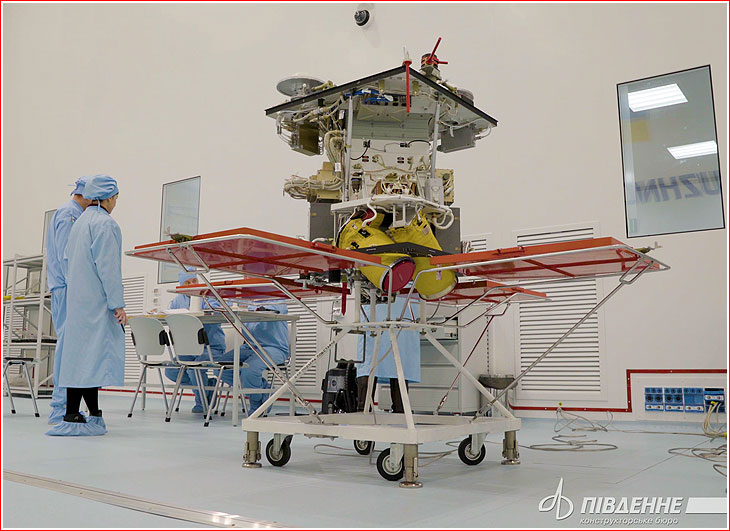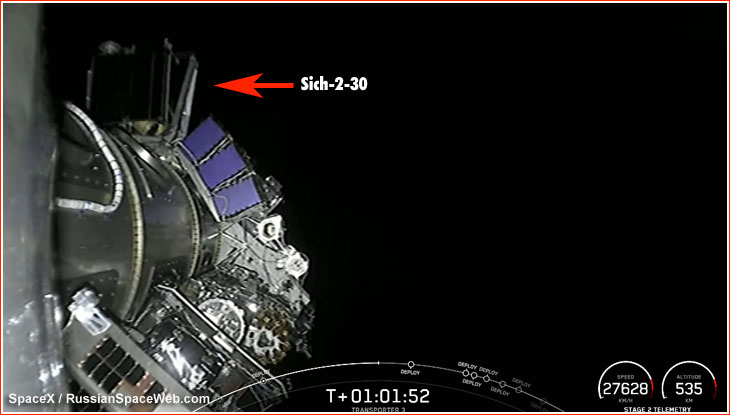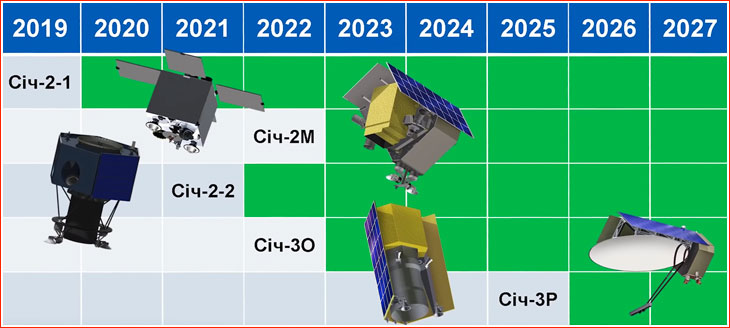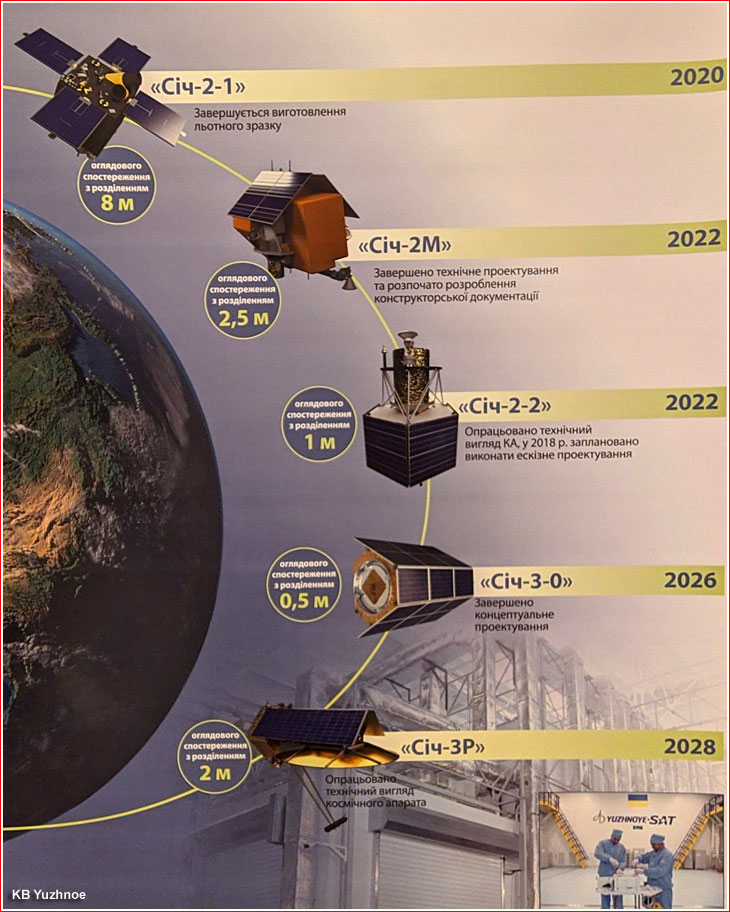Ukraine returns to space with Sich-2-30 (original) (raw)
Ukraine returns to space with
Sich-2-30
After a decade-long break, a satellite built in Ukraine entered Earth's orbit on Jan. 13, 2022. Reflecting seismic political changes in the world and the completely new space business scene emerged in the past 10 years, the Sich-2-30 remote-sensing satellite was carried into space from American soil aboard Space-X' Falcon-9 rocket, instead of a converted Soviet ballistic missile deployed on a Russian territory, as was used by its predecessor Sich-2.

Partially assembled Sich-2-1 KB satellite at Yuzhnoe circa 2020. Two cylindrical star trackers at the bottom of the spacecraft which will be facing zenith during the orbital flight.
Specifications of the Sich-2-1 (Sich-2-30) satellite:
| Satellite liftoff mass | 165 kilograms** |
|---|---|
| Orbital altitude | approximately 700 kilometers |
| Orbital inclination | 98.26 degrees toward the Equator |
| Life span | 5 years* |
| Pan-chromatic imaging range | 0.51-0.90 micrometers |
| Multi-spectral imaging range | 0.51-0.59 micrometers (green channel) 0.61-0.68 micrometers (red channel) 0.80-0.89 micrometers (near infrared) |
| Infrared imaging range | 1.51-1.7 micrometers |
| Imaging resolution in pan-chromatic mode | 8.2 meters* |
| Imaging resolution in multi-spectral mode | 8.2 meters* |
| Imaging resolution in infrared mode | 41.6 meters* |
| Imaging swath in nadir in pan-chromatic mode | 48.8 kilometers* |
| Imaging swath in nadir in multi-spectral mode | 48.8 kilometers* |
| Imaging swath in nadir in infrared mode | 58.1 kilometers* |
| Spacecraft rotation range | +/– 35 degrees from nadir |
| Operational life span | 5 years* |
*Specs as of 2015 had changed due to a switch of the launch provider
**210 kilograms, according to official sources in 2022
Origin of the Sich-2-30 project
The Sich-2-30 micro-satellite was built at KB Yuzhnoe design bureau in the Ukrainian city of Dnipro with the goal of providing images of the Earth's surface.
At the time when the preceding Sich-2 (MS-2-8) satellite stopped operating in 2012, the Ukrainian space agency hoped that a follow-on spacecraft, then known as Sich-2-1, would launch before the end of 2014. It happened to be exactly the year when the Ukrainian government with close ties to Moscow had collapsed and Kyiv turned to the West. For the country's already cash-strapped space industry, it meant an abrupt end of the two-way cooperation with Russia, the loss of critical contractors and the end of orders for Ukrainian hardware and services from its main customer.
Without its own launch site and the full production cycle for space delivery systems, Ukraine had to find a new way to develop its space potential. Like many other emerging space powers, Kyiv banked on the development of low-cost application spacecraft which could provide valuable dual-use (military and civilian) services and help preserve core expertise until better days for the nation's economy.
In 2015, the Ukrainian space agency attempted to resume funding for several small satellite projects at Dnipro-based KB Yuzhnoe, which had decades-long experience with building satellites, most lately Tselina-2 electronic-intelligence spacecraft for the Russian military. Within the new federal program, Sich-2-1 was the first in line, targeted for launch in 2017. The micro-satellite closely resembled its short-lived siblings: the short-lived EgyptSat-1 launched in 2007 for the Egyptian government and a more successful Sich-2 launched in 2011. The active development of the Sich-2-1 started back in 2013, but was interrupted for around two years by political upheavals and subsequent economic realignment in Ukraine.
As of 2015, the project was expected to cost 898 million hryvnia ($32.6 million) and a part of the funding was expected to come from KB Yuzhnoe's own profits from various commercial projects. Other sources estimated the satellite's price tag at $8-10 million.
What is known about Sich-2-30
Like its predecessors, the 170-kilogram Sich-2-1 was originally designed to operate from a near-polar orbit at an altitude of just under 700 kilometers. The satellite was to be equipped with a three-axis gyroscopic attitude-control system, which would be used to point a medium-range optical-electronic imager toward targets on Earth. Originally, the camera capable of producing stereo photographs was expected to operate in pan-chromatic and multi-spectral modes, capturing details as small as 8.2 meters, as well as in the infrared mode with a resolution of 58.1 meters.
If successful, the Sich-2-30 project could contribute remote-sensing data to the European Copernicus program, which provides global imagery of the Earth's surface. The satellite was also designed to gather scientific data about the condition of the ionosphere.
The satellite was designed to have a life span of five years.
The optical equipment of Sich-2-1 was developed at the Arsenal factory in Kyiv. The Khartron-YuKOM enterprise built its Sub-system for Determining and Controlling the Attitude, POUO, while Khartron-ARKOS built the telemetry system for the service module and its software. The satellite was also equipped with two star trackers: one SST-20S from South Korea and the MAIS-B built in Ukraine, to provide redundancy for the critical function of navigating in space.
MAIS-B was originally developed for Ukraine's Microsat scientific satellite, which had been under development since around 2012, as an experimental payload for the first test launch of the Tsyklon-4 rocket from a planned spaceport of Alcantara in Brazil. Because the entire Tsyklon-4 project was abandoned in the mid-2010s, the MAIS-B never had a chance to be tested in space.
These instruments had replaced Russian-built Angular Momentum Measurers, IUS, and star trackers, ZD, which navigated previous Ukrainian satellites and were originally planned for Sich-2-1.
KB Yuzhnoe also had to replace some Ukrainian-built avionics originating from the eastern region of the country that was lost to Russia in 2014. In addition, Ukrainian-built electric magnets flight-tested on Egyptsat-1 and Sich-1 had to be replaced with Canadian systems and the Ukrainian communications package was replaced with a analogous French sub-system. The reaction wheels, which would provide orientation of the satellite, were supplied by a Canadian company MSCI.
The ground control station for the satellite was planned to be deployed in the town of Dunaevtsy in the Khmelnitsky Region of Western Ukraine. The site traces its history to the Soviet period, but had to go through major upgrades ahead of the Sich-2-30 launch.
Switching launch provider
After its stop-and-go development, Sich-2-1 reached integrated tests in 2020. With the approaching 30th anniversary of Ukraine's independence in 2021, the satellite was renamed Sich-2-30 and received additional political support with an official endorsement of the project by the Ukrainian president Volodymyr Zelensky in early 2021.
The satellite was originally intended for launch either on the Dnepr launcher based in Russia and Kazakhstan or on the Tsyklon-4 rocket planned for launches from Brazil. None of these Ukrainian-built vehicles were available at the time of the project completion, so in November and December 2020, the Ukrainian space agency began the search for an outside launch provider. In December, it received an offer from Germany-based Exolaunch representing US-based SpaceX. At the same time, the agency began direct negotiations with SpaceX that resulted in an agreement on Jan. 18, 2021.
According to Ukrainian space officials, Sich would be launched at a price tag of $1.99 million on a Falcon-9 rocket during its Transporter-3 "ridershare" mission, which SpaceX offered to commercial users.
The Ukrainian space agency later disclosed that the launch on Transporter-3 posed serious technical challenges to the delivery of the satellite to its required orbit, though it did not provide details. Independent observers noted that due to the sideway position of the satellite on the payload adapter of the Falcon-9 rocket instead of its top position on Dnepr or Tsyklon-4, the separation dynamics of the Sich-2-30 had to be reworked.
It is also possible that the conditions of the "ridershare" launch required releasing the satellite at a lower orbit than originally planned (at an altitude of around 550 kilometers instead of between 663 and 682 kilometers in the original project). That change actually increased the resolution of the satellite's optical instrument from 8.2 meters and narrowed its imaging swath to around 36.5 meters.
In 2021, KB Yuzhnoe cited a resolution of around 7.8 meters for pan-chromatic images taken in nadir shooting mode (when the camera is pointed along the vertical line perpendicular to the Earth surface) and 35 meters for infrared images. However, it might have been achieved at the price of a shortened overall mission. According to the latest specifications, Sich-2-30 was projected to operate for three years instead of the five years previously cited for the satellite.
On Feb. 9 and 10, 2021, officials from the agency and from KB Yuzhnoe discussed the issues with the launch provider and in the Spring of 2021, Ukraine struck a deal with the European company ISILaunch to integrate Sich-2-30 with Falcon-9.
Final push
Despite the major political support and renewed public attention that the Sich-2-1 had received early in 2021, the project was not out of the woods yet.
On Feb. 11, 2021, the Ukrainian space agency publicly pushed back against all the fanfares by government officials about the impending launch. It reminded the public that the work on the satellite was at a standstill as late as December 2020. The agency's press-release cited the Jan. 13, 2021, status report from KB Yuzhnoe, estimating the readiness of Sich-2-30 at 85 percent and its ground segment at just 45 percent. According to the official schedule, the completion of the project was not expected until at least May 2021, while the ground facilities were not expected to be ready until the 4th quarter of 2021, the agency said.
KB Yuzhnoe listed the following work left to be completed on the project:
- Electro and radio tests, ERTI, and the respective amendment to the technical documentation based on the results of the tests;
- Magnetic tests;
- Final certification of the spacecraft with flight qualification at Level O;
- The manufacturing of the flight model according to the technical conditions;
- The formal extension of the life span for the satellite's sub-systems, which were originally scheduled for launch in 2017;
- Certification of the spacecraft for the shipment to the launch site.
Much of these tasks appeared to be relatively minor except for a strange line item about the manufacturing of the flight model, which clearly contradicted multiple reports and photos of the fully assembled satellite published by KB Yuzhnoe itself in the previous few months. Perhaps, KB Yuzhnoe and its parent agency used the sudden limelight to drive a point home for the officials in Kyiv holding the purse strings that the project still needed adequate funding in its homestretch.
In the same press release, the agency stressed that during the period between November and December 2020, it requested that parliament allocate more than 200 million hryvnas ($6.39 million) for the launch of the satellite in the 2021 state budget, but to no avail. At the same time, the worsening financial situation at KB Yuzhnoe (greatly exacerbated by the coronavirus), prevented the company from allocating its own funds for the goal. On Jan. 28, 2021, the agency requested the government to re-allocate funds from the defunct Tsyklon-4 project to the Sich launch, but had received no reply, the agency said in its February 11 statement.
The industry's negative public relations campaign apparently worked, because in April 2021, Ukrainian media reported that the country's government had approved the funding required for the completion of the Sich-2-30 project and its launch on the Falcon-9 rocket by the end of 2021.
In August 2021, the institute of magnetism of the Ukrainian Academy of Sciences in Kharkov announced the successful completion of the qualification tests confirming the magnetic properties of the Sich-2-30, using the full-scale prototype of the spacecraft along with mockups of its payload adapter and the separation system.
On October 19, the International Telecommunications Union, ITU, confirmed the registration of radio frequencies for the Sich-2-1 project.
By the end of October 2021, SpaceX delayed the Transporter-3 launch from the end of 2021 to January 2022, but on Dec. 8, 2021, the flight version of the satellite was shipped from Ukraine to the United States for integration with the Falcon-9 rocket at Cape Canaveral.
Launch scenario
At the time, the launch was planned for Jan. 10, 2022, but before the end of December 2022, it was finally set for January 13. On that day, the rocket lifted off as scheduled from Space Launch Complex 40, SLC-40, at 10:25 a.m. EST, leaving unused a backup opportunity at the same time on January 14. On both days, the mission had a 29-minute window.
Sich-2-30 was one of 105 spacecraft sharing a ride to orbit aboard the two-stage Falcon-9 Block 5 rocket. Its reusable first stage had previously made nine launches, according to SpaceX. During the Transporter-3 flight, the first stage completed its firing and separated from the second stage 2 minutes and 19 seconds in flight. The booster then used its propellant reserves to perform descent and touchdown at Landing Zone 1, LZ-1, at Cape Canaveral Space Force Station, 8 minutes and 27 seconds after liftoff.
In the meantime, just seven seconds after parting with its first stage, the second stage took over the powered ascent, firing until 8 minutes 26 seconds in flight. The payload fairing was dropped off slightly more than a minute into the second-stage burn and it was expected to be recovered from the Atlantic Ocean.
Orbital maneuvers

Upon reaching an initial orbit, the second-stage booster performed a coasting flight, before restarting its engine 55 minutes 22 seconds in flight. The maneuver lasted just two seconds placing the stage in its near-polar target orbit. The deployment of the first payload took place slightly more than four minutes later and all 105 satellites took their turns separating from the payload adapter within following 1.5 hours. A total of 82 deployment events were scheduled, with some satellites separating simultaneously.
Sich-2-30 was ejected from the rocket's second stage 1 hour 23 minutes 2 seconds after liftoff (18:52 local time in Ukraine on Jan. 13, 2022) as the vehicle was overflying Northern coast of Greenland at an altitude of 548 kilometers. By that time, three more payloads still remained aboard the launch vehicle and were deployed in the following few minutes.
Ground specialists troubleshoot problems with Sich-2-30
Soon after release of Sich-2-30 from the second stage of the Falcon-9 rocket on Jan. 13, 2022, KB Yuzhnoe announced that its satellite had established communications with ground control, had deployed its solar panels and had been in good health. According to a representative of the ground control station in Dunaevtsy, the satellite downlinked its first data around 21:00 local time. The spacecraft testing period was expected to last two months, although the first image was initially expected to be received on the ninth day of the mission.
However, only on Jan. 27, 2022, KB Yuzhnoe announced that despite the initial contact with the spacecraft after its release from the launch vehicle, the peculiarities of a cluster launch had prevented mission control from establishing stable communications with the spacecraft and from placing the satellite into its operational attitude. In its resulting orientation, solar panels on Sich-2-30 were exposed only to the sunlight bounced from the surface of Earth or to the direct sunlight coming under very shallow angle. The combination of these factors adversely impacted power balance aboard the spacecraft, Yuzhnoe said. Nevertheless, according to the design bureau, built-in operational algorithms and the design of the spacecraft enabled an independent re-boot of its flight control system and the resumption of its functions in the power-saving mode. The subsequent communications sessions did confirm that there were no failures of onboard equipment, the company said.
Modeling of the satellite's motion dynamics taking into account external factors, including the interaction of the spacecraft with the Earth's magnetic field, gravitational and aerodynamic influences, has indicated that within one or two months, the orientation of the spacecraft would become favorable for power accumulation, which would make it possible to put the spacecraft into its operational attitude, Yuzhnoe said, "At this point, specialists of the National Control and Testing Center along with KB Yuzhnoe specialists maintain communications with the satellite and analyze its telemetry data in preparation for continuing flight tests."
What's next for Sich-2-30
Based on limited available information, independent experts suggested that the unusual predicament experienced by Sich-2-30 could be caused by a problem in the flight control or in the attitude control system aboard the satellite. Depending on the severity of the issue and the affected system, different salvage scenarios could be attempted, even though real chances for a full recovery of the spacecraft were considered to be low as of early February 2022.
Beyond Sich-2-30
In parallel with the Sich-2-1 project, the Ukrainian industry worked on the renovation of assembly and testing facilities at KB Yuzhnoe and on the formation of the new ground control center.
From the outset, the Ukrainian space agency advertised Sich-2-1 as the first step in the development of a series of increasingly sophisticated satellites for remote-sensing applications with improving spatial resolution, first to one meter and then to half a meter. The final step of the program was expected to be a radar-carrying spacecraft for all-weather day and night imagery.
Obviously, the program would depend on the economic situation in the country and on stable funding.

The Sich family development timeline as of 2019.

The Sich family development timeline as of 2020.
Page author: Anatoly Zak; Last update:October 13, 2022
Page editor: Alain Chabot; Last edit: January 12, 2022
All rights reserved